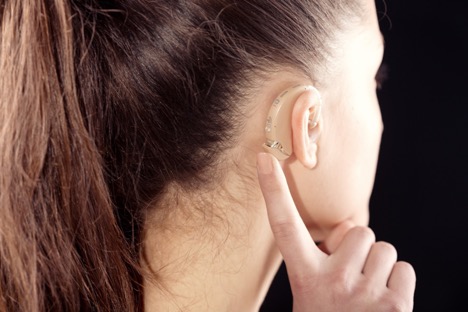
Katie Brown is a first year PhD student at Duncan of Jordanstone College of Art and Design in Dundee. Her research project is titled: Exploring hearing aids and super normal design. Her supervisors are Dr Graham Pullin and Dr Rodney Mountain. Check out Katie’s research site.
Hearing aids seem to be easily separated into two categories of appearance. Firstly, beige, pseudo skin coloured devices that aim to conceal themselves, yet become more conspicuous in their attempt at invisibility. And secondly, metallic, almost robotic designs that seem to take inspiration from 90s consumer electronics and science fiction. Generally, all of these are plastic, with small fiddly controls that seem counterintuitive to the needs of elderly users. We argue that these designs are archaic and continue to represent an outdated medical model of disability. Portraying disability as something to be treated, fixed and if all else fails, concealed. Stigma around hearing loss and d/Deafness remains prominent, in part, due to this perspective.
There are many wearers and not-yet-wearers of hearing aids. From those who are D/deaf to those who are experiencing hearing loss. To be Deaf ‘with a big D’ is to be culturally Deaf, to use British Sign Language (BSL) as your primary language and to place yourself within the Deaf world. Whereas to be deaf ‘with a small d’ means that you have been medically diagnosed as deaf, however, you do not identify as being a part of the Deaf world or describe yourself as culturally Deaf. An example of this may be a person deafened through illness in adulthood. Even though a said person may be medically ‘deaf,’ they identify predominantly with the hearing world in which they were raised. It is widely agreed that as a society, we are progressing towards inclusion and a shift into understanding disability as being part of the fabric of everyday life. Why then is it that the most desirable design quality in a hearing aid is still that of invisibility? Consider a pair of glasses, another prosthesis that aims to aid. Glasses are widely regarded as highly fashionable, desirable accessories, with a wide democracy of choice involved in the process. Yet hearing aids, especially those fitted through the NHS, continue to lack this democracy of choice.
The temptation thus far has been to separate groups of hearing aid wearers into their extremes. Those who are D/deaf and proud, and those who are deaf/hearing impaired and experiencing a transitional change. Designers may be enticed into playing with these extremes, creating bold or muted hearing aid designs. We argue that this is an over-simplistic view of an incredibly complex and diverse group of people. Many wearers may prefer neither a whisper nor a shout, but instead, something that more accurately communicates everyday experience and subtle perspectives on “disability.” Hearing aids that are ‘every-day’, normal even. This is where super normal design may offer a unique perspective to disability design.
Super normal came to the attention of the design world in 2006, when Naoto Fukasawa and Jasper Morrison curated an exhibition of 210 products, showcasing objects that, “pass the test of every day.” On first glance, these objects appear unremarkable, un-designed. However, these are products that have become invisible through their everyday-ness, they are designs that appear to be un-designed and their heightened normality is what makes them super normal.
This is a particularly interesting design philosophy when looking at hearing aids and challenging their role as stigma objects. There is a juxtaposition here between normalcy and disability, super normal design may be able to explore this tension. Might super normal sensibilities allow designers to create disability objects that are the new normal? Looking not to conceal or ‘cover’ the hearing aid, but to create understated, even iconic designs. We argue that hearing aids are an important tool in communicating and normalising impairment and therefore should be visible. Not only visible but accepted, designed in a way that accurately represents an image of self that the wearer is proud and unapologetic about displaying. Super normal design practice may offer the subtle touch that design for disability often lacks, positioning disability as part of the fabric of everyday life.
My research into hearing aids aims to explore nuance, through research into the experience of hearing aid wearers, with a particular focus on felt stigma. This research aims to take a “no triumph, no tragedy” stance. Portraying disability objects as things like any other. This research asks, what if hearing aids were designed with more nuance? As wearers consciously make decisions to cover or uncover their ‘disability,’ the design of hearing aids could reflect more nuanced attitudes towards disability. There is a gap in the market for subtle designs that address these decisions and more accurately represent their wearers. This research project asks, what would a super normal hearing aid look like? And further, who might wear one?
This ongoing research calls for wearers of hearing aids to act as mentors for the project. The political and participatory stance of “nothing about us, without us” resonates at the core of this research. If you are a hearing aid wearer based in Dundee or the surrounding area, and you would be willing to give your time at this stage of the research through an interview, please contact Katie.



